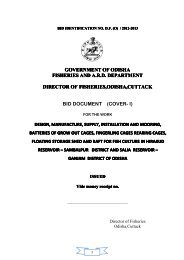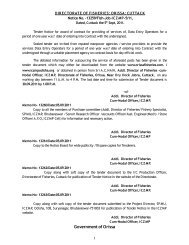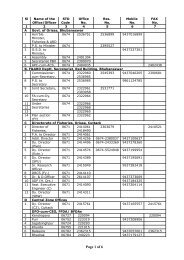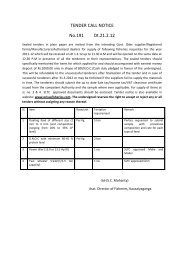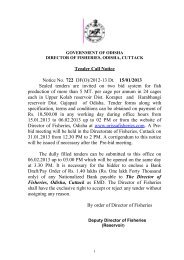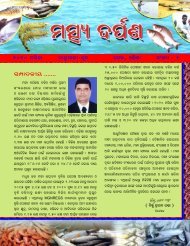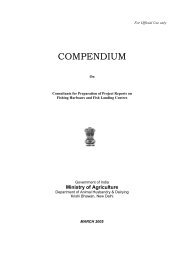Value Chain Analysis of Fishery in Puri and Ganjam District of Orissa
Value Chain Analysis of Fishery in Puri and Ganjam District of Orissa
Value Chain Analysis of Fishery in Puri and Ganjam District of Orissa
You also want an ePaper? Increase the reach of your titles
YUMPU automatically turns print PDFs into web optimized ePapers that Google loves.
Draft Report on “<strong>Fishery</strong> Supply <strong>Cha<strong>in</strong></strong>”<br />
Confidential<br />
Additionally 10 per cent <strong>of</strong> the auction value is deducted by the gaddiwala<br />
on the account <strong>of</strong> losses <strong>in</strong>curred due to dry<strong>in</strong>g.<br />
The prices, though determ<strong>in</strong>ed at the auctions, are not paid on the spot.<br />
The payments normally take place at the end <strong>of</strong> the day or the next day.<br />
S<strong>in</strong>ce no documentation is done, some respondents as well as NGO<br />
<strong>of</strong>fice bearers cited <strong>in</strong>stances when the fishermen is paid further less as<br />
quantities are tampered with <strong>and</strong> only the buyer has “sale record”<br />
The “ocular” weigh<strong>in</strong>g is<br />
always <strong>in</strong> the favour <strong>of</strong><br />
the buyer <strong>and</strong> not the<br />
fishermen. On an<br />
average the fisherman<br />
loses 10-15% <strong>of</strong> the<br />
catch here itself.<br />
8.3.3 Political<br />
Most <strong>of</strong> the “patrons” enjoy the patronage <strong>of</strong> political leaders. The<br />
political patronage is obta<strong>in</strong>ed through provision <strong>of</strong> percentage stake<br />
<strong>in</strong> the bus<strong>in</strong>ess, party donations or outright payments for gett<strong>in</strong>g<br />
favourable decisions <strong>and</strong> policies.<br />
People <strong>in</strong> hushed tones<br />
talk about the prevalence<br />
<strong>of</strong> “Mafia” like control<br />
over the fishery supply<br />
cha<strong>in</strong> – <strong>in</strong> the entire state<br />
by a select group <strong>of</strong><br />
exporters/wholesalers<br />
It also allows the “patrons” to undertake subversive activities to<br />
damage a rival’s bus<strong>in</strong>ess or <strong>in</strong>dulge <strong>in</strong> high h<strong>and</strong>edness with<br />
fishermen. E.g. <strong>in</strong> Paradip <strong>and</strong> Gopalpur it was mentioned by a few<br />
respondents that there have been <strong>in</strong>stances when a lead<strong>in</strong>g patron<br />
has outrightly challenged his rivals <strong>and</strong> gone to the extent <strong>of</strong> bomb<strong>in</strong>g the rival’s vehicles.<br />
8.3.4 Gender<br />
Women play an important role <strong>in</strong> the fish supply cha<strong>in</strong> at the village level. Typically, they are<br />
entrusted with the role <strong>of</strong> 1) sale <strong>of</strong> the low value products <strong>in</strong> <strong>and</strong> around the villages, 2) salt<strong>in</strong>g<br />
<strong>and</strong> dry<strong>in</strong>g <strong>of</strong> fish <strong>and</strong> 3) sale <strong>of</strong> dried fish.<br />
However, they have limited or negligible say <strong>in</strong> decision-mak<strong>in</strong>g process as the entire process <strong>and</strong><br />
procedures <strong>in</strong> the cha<strong>in</strong> is highly male dom<strong>in</strong>ated.<br />
The auction <strong>of</strong> the catch is a doma<strong>in</strong> <strong>of</strong> the males <strong>and</strong> the women actors have negligible role to<br />
play. Their participation <strong>in</strong> the entire process is limited to products <strong>of</strong> generic nature <strong>and</strong> not <strong>of</strong><br />
<strong>in</strong>terest to their male counterparts.<br />
The women have a high <strong>in</strong>volvement <strong>in</strong> the ancillary support services but the exploitation by the<br />
dom<strong>in</strong>ant players <strong>in</strong> terms <strong>of</strong> wages is prevalent. Other <strong>in</strong>stances <strong>of</strong> exploitation can be seen <strong>in</strong><br />
the market where the women are the majority retailers <strong>and</strong> are harassed by the collectors <strong>of</strong> the<br />
market cess, Other po<strong>in</strong>ts worth mention<strong>in</strong>g is the lack <strong>of</strong> basic amenities to encourage women to<br />
play a important role <strong>in</strong> the cha<strong>in</strong>.<br />
The dry fish market at Uma is the largest <strong>in</strong> the region. The dry fish preparation <strong>and</strong> market<strong>in</strong>g is<br />
normally the doma<strong>in</strong> <strong>of</strong> the women. The trade <strong>in</strong> Uma market starts <strong>in</strong> the morn<strong>in</strong>g at 4 am <strong>in</strong> the<br />
morn<strong>in</strong>g <strong>and</strong> hence the women sellers have to spend the night <strong>in</strong> the market yard where physical <strong>and</strong><br />
sexual exploitation have been reported. The women sellers reported that the market cess collector<br />
harass them on the charges for the produce <strong>and</strong> <strong>of</strong>ten unduly charge them.<br />
The other problem is the lack <strong>of</strong> basic amenities <strong>and</strong> <strong>in</strong>frastructure like toilets, retir<strong>in</strong>g rooms etc. In its<br />
absence, they are forced to relieve themselves <strong>in</strong> the open; sleep <strong>in</strong> the open <strong>in</strong> the market sheds,<br />
which creates problems.<br />
8.3.4 Others<br />
The fish supply cha<strong>in</strong> –be<strong>in</strong>g highly perishable is totally dependent on the timely availability <strong>of</strong> icecrushed<br />
/flakes for extend<strong>in</strong>g the keep<strong>in</strong>g quality as well as the shelf life. This aga<strong>in</strong> is controlled<br />
either directly/<strong>in</strong>directly by the “patrons”. Throughout the study <strong>and</strong> field visits, the NiMble team did<br />
not sight an ice factory <strong>in</strong> the vic<strong>in</strong>ity <strong>of</strong> the l<strong>and</strong><strong>in</strong>g centers. Enquiries revealed that ice was<br />
Submitted by -: NiMble System Pvt. Ltd.<br />
Submitted to -: OXFAM (India) Trust 54



